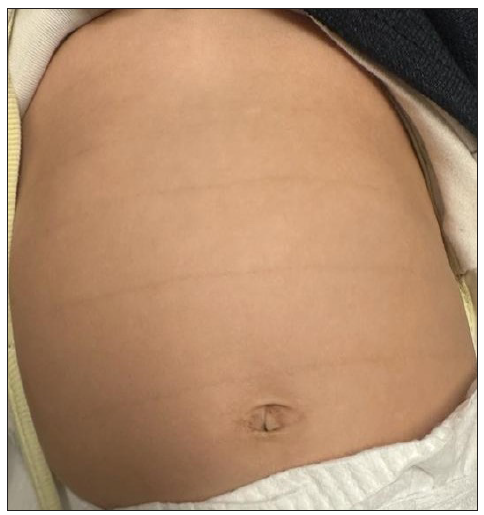Transient pigmentary lines of the newborn
Corresponding author: Dr. Murat Ozturk, Department of Dermatology, Van Training and Research Hospital, Van, Turkey. chayacholic@hotmail.com
-
Received: ,
Accepted: ,
How to cite this article: Ozturk M, Coskun S. Transient pigmentary lines of the newborn. Indian J Dermatol Venereol Leprol. doi: 10.25259/IJDVL_464_2024
Dear Editor,
Transient pigmentary lines of the newborn are sporadic lesions among the benign temporary cutaneous lesions.1 Clinically, it manifests as linear hyperpigmented bands located horizontally in the skin folds of the back, abdomen, and extremities.1,2 Although the aetiology is not fully known, it is suggested that intrauterine flexion may cause inflammation and hyperkeratosis, resulting in hyperpigmentation in skin folds. As this is a clinical diagnosis, laboratory tests or imaging are not necessary.3,4
An 8-month-old, healthy baby boy presented with brown lines on the abdomen from birth that faded over time. On cutaneous examination, multiple horizontal and parallel hyperpigmented lines following the skin folds were seen on the abdomen [Figure 1]. Family history was non-contributary. Parents were counselled about the benign and self-resolving nature of the condition.

- Multiple horizontal and parallel hyperpigmented lines following skin folds on the abdomen.
Around 12 cases of transient pigmentary lines of the newborn have been reported in the literature. These lines are seen on the back, abdomen, and extremities at birth or shortly after birth. Familial history has been reported in a few cases. Most of the cases described so far have been in the black male newborns, and rarely seen in Caucasian babies.3 Our case was a Caucasian child with no family history.
Differential diagnoses include congenital adrenal hyperplasia, linear and whorled naevoid hypermelanosis, keratinisation disorders (collodion baby, ichthyosis vulgaris), and incontinentia pigmenti.1,2 Since the hyperpigmentation resolves in 2-6 months, it can often be overlooked, hence its reporting may be low.3 In our case, the history was 8 months old, and it was learned that the lines had faded gradually. Rarely lesions may persist up to one year after birth, as in our case.
Treatment is not warranted, as the pigmented lines resolve within a few months. However, it is essential to make an appropriate diagnosis to differentiate them from a possible genetic disorder or serious skin disease. Counselling of the parents remains the cornerstone of management.2-4
Declaration of patient consent
The authors certify that they have obtained all appropriate patient consent.
Financial support and sponsorship
Nil.
Conflicts of interest
There are no conflicts of interest.
Use of artificial intelligence (AI)-assisted technology for manuscript preparation
The authors confirm that no artificial intelligence (AI)-assisted technology was used to assist in the writing or editing of the manuscript, and no images were manipulated using AI.
References
- Transient pigmentary lines of the newborn. An Pediatr (Engl ed). 2023;99:217-8.
- [CrossRef] [PubMed] [Google Scholar]
- Transient pigmentary lines of the newborn. J Pediatric. 2023;263:113662.
- [CrossRef] [PubMed] [Google Scholar]
- Pigmentary lines of the newborn: A case report oath review of the literature. Dermatology. 2014;228:198-201.
- [CrossRef] [PubMed] [Google Scholar]
- Transient pigmentary lines of the newborn. Pediatr Dermatol. 2009;26:768.
- [CrossRef] [PubMed] [Google Scholar]





